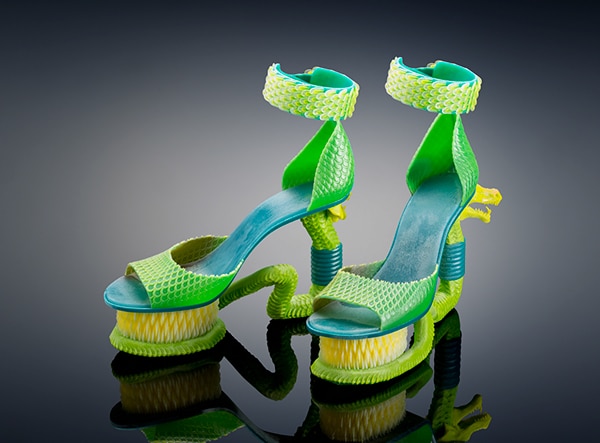This opinion piece was written by designer Michaella Janse von Vuuren.
I still remember vividly the first time I came across 3D printing in 2004. It was an online video, and it blew my mind. I [designer Michaella Janse van Vuuren] enrolled in a post-doctorate in medical implant design, the only way I could access rapid prototyping at the time in South Africa. I believed I needed a serious technical arsenal to be able to make my own digital fantasies real. What I found instead is that everything you need can be accessed easily on the Internet. For me, 3-D printing and digital manufacturing have broken down the walls that separated industries. I have been a jeweler, sculptor, educator, lighting, fashion and shoe designer and researcher in medical implant design.
Digital technology has the enormous potential to remove the barriers to manufacturing. In theory, it no longer matters where you reside.
Consider that I live in Africa, and my home is surrounded by Bushveld. Thanks to the magic of digital manufacturing all I need to create my 3-D-printed pieces is my Internet connection, my computer and a digital tablet. I do not even own a 3-D printer.
As 3-D printing catches the world’s attention, there’s a kind of gold-rush fever that’s threatening to cheapen the potential of the technology. Anyone can download designs for free and print them at home. 3-D design software companies have spread the message that designing for manufacturing is so easy that the skills of people who make the designs become practically worthless.
This is very far from an accurate view. There are many challenges facing independent 3-D manufacturers all over the world. These include the cost of design hardware, software and the 3-D printing itself, limitations of the printing materials for end-product use and the constraints of the machines. You need to have knowledge of legal issues, business and marketing skills and access to experts.
The magic ingredient to transform yourself from a pencil wielding dreamer to an indie manufacturing powerhouse is perseverance and a lot of it. Computer design software has grown out of the engineering manufacturing needs of old. The 3-D printing machines are capable of printing shapes never before possible, but the software still has to catch up when it comes to easily design these shapes.
The power of digital manufacturing is that the design skills needed to create jewelry, medical implants or fashion are very similar. What changes is the level of expert knowledge needed to create a functional design? To design a shoe you have to partner with a shoe expert. You can make medical implants, but you have to work with an expert orthopedic surgical team.
When considering the design of a manufactured object, you also need to investigate the materials you will be printing in and what is actually possible on a particular machine. Note: “You can print anything” is a big ol’ lie. That future has still to arrive.
Once your design is finished, you can send it to be printed. What happens to the file is now out of your control. Make sure you print through someone reputable. If your file gets “out there” you cannot get it back.
- Extreme Serpent Shoes 3D design by Dr. Michaella Janse van Vuuren Stratasys – Model Lerato Moloi – Photo by Merwelene van der Merwe studio.
- Extreme Serpent Shoes 3D design by Dr. Michaella Janse van Vuuren Stratasys – Model Lerato Moloi – Photo by Merwelene van der Merwe studio.
- Extreme Serpent Shoes 3D design by Dr. Michaella Janse van Vuuren Stratasys – Model Lerato Moloi – Photo by Merwelene van der Merwe studio.
Extreme Serpent Shoes 3D design by Dr. Michaella Janse van Vuuren Stratasys – Model Lerato Moloi – Photo by Merwelene van der Merwe studio.
Hyphae Pendant Lamp by Nervous SystemPrinting can be very expensive; designers often team up with large 3-D corporations. Print sponsorships are great but don’t get so flattered and excited that you forget to have your designs well protected and legally covered. If you live far from New York or London or any of the other cities considered as economic hubs, distance is another challenge. A trip to showcase your work and network at one of the best expos or conferences is a huge financial strain, but nothing beats meeting in person. So despite the ability to print anywhere in the world, if you are not close enough to the financial centers you are at a disadvantage.
That brings us to finances. To cover all the hardware, software, R&D, self-study, test prints, marketing and traveling you better have a very inventive plan. It is the rare designer who has 3-D print sales capable of sustaining the business. South African Richard van As’ Robohand is an open-source low-cost 3-D prosthetic that has changed lives all over the world, and as the 3-D print market increases, I expect international designers like Nervous System, Francis Bitonti and Joshua Harker to have a big influence on the emerging industry. When the materials improve and become less expensive, digital manufacturing will take off and established brands will join in.















